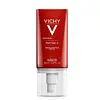What's inside
What's inside
 Key Ingredients
Key Ingredients

 Benefits
Benefits

 Concerns
Concerns

 Ingredients Side-by-side
Ingredients Side-by-side

Butyl Methoxydibenzoylmethane 3%
UV AbsorberHomosalate 5%
Skin ConditioningEthylhexyl Salicylate 5%
UV AbsorberOctocrylene 7%
UV AbsorberWater
Skin ConditioningGlycerin
HumectantDimethicone
EmollientSilica
AbrasivePEG-100 Stearate
Glyceryl Stearate
EmollientGlycolic Acid
BufferingStearic Acid
CleansingDicaprylyl Carbonate
EmollientSteareth-100
Gel FormingDimethicone/Vinyl Dimethicone Crosspolymer
Skin ConditioningSodium Hydroxide
BufferingSodium Hyaluronate
HumectantMyristic Acid
CleansingCyclodextrin
AbsorbentPalmitic Acid
EmollientPhenoxyethanol
PreservativePhenylethyl Resorcinol
AntioxidantGuanosine
Skin ConditioningAmmonium Polyacryloyldimethyl Taurate
Emulsion StabilisingAscorbyl Glucoside
AntioxidantTocopherol
AntioxidantCaprylyl Glycol
EmollientTrisodium Ethylenediamine Disuccinate
Xanthan Gum
EmulsifyingPentaerythrityl Tetra-Di-T-Butyl Hydroxyhydrocinnamate
AntioxidantPisum Sativum Extract
Skin ConditioningParfum
MaskingButyl Methoxydibenzoylmethane 3%, Homosalate 5%, Ethylhexyl Salicylate 5%, Octocrylene 7%, Water, Glycerin, Dimethicone, Silica, PEG-100 Stearate, Glyceryl Stearate, Glycolic Acid, Stearic Acid, Dicaprylyl Carbonate, Steareth-100, Dimethicone/Vinyl Dimethicone Crosspolymer, Sodium Hydroxide, Sodium Hyaluronate, Myristic Acid, Cyclodextrin, Palmitic Acid, Phenoxyethanol, Phenylethyl Resorcinol, Guanosine, Ammonium Polyacryloyldimethyl Taurate, Ascorbyl Glucoside, Tocopherol, Caprylyl Glycol, Trisodium Ethylenediamine Disuccinate, Xanthan Gum, Pentaerythrityl Tetra-Di-T-Butyl Hydroxyhydrocinnamate, Pisum Sativum Extract, Parfum
Glycerin
HumectantDecyl Oleate
EmollientOctyldodecanol
EmollientRicinus Communis Seed Oil
MaskingButyrospermum Parkii Butter
Skin ConditioningC18-38 Alkyl Hydroxystearoyl Stearate
EmollientCaprylic/Capric Triglyceride
MaskingCetearyl Alcohol
EmollientDicaprylyl Carbonate
EmollientBis-Diglyceryl Polyacyladipate-2
EmollientHydrogenated Coco-Glycerides
EmollientCetyl Palmitate
EmollientPolyglyceryl-3 Diisostearate
EmulsifyingBeeswax
Emulsion StabilisingHydrogenated Castor Oil
EmollientUrea
BufferingGlycine
BufferingSodium PCA
HumectantArginine Hcl
Skin ConditioningSodium Ascorbyl Phosphate
AntioxidantTocopherol
AntioxidantHelianthus Annuus Seed Oil
EmollientWater
Skin ConditioningMagnesium Stearate
Cosmetic ColorantMagnesium Sulfate
Decylene Glycol
Skin ConditioningGlycerin, Decyl Oleate, Octyldodecanol, Ricinus Communis Seed Oil, Butyrospermum Parkii Butter, C18-38 Alkyl Hydroxystearoyl Stearate, Caprylic/Capric Triglyceride, Cetearyl Alcohol, Dicaprylyl Carbonate, Bis-Diglyceryl Polyacyladipate-2, Hydrogenated Coco-Glycerides, Cetyl Palmitate, Polyglyceryl-3 Diisostearate, Beeswax, Hydrogenated Castor Oil, Urea, Glycine, Sodium PCA, Arginine Hcl, Sodium Ascorbyl Phosphate, Tocopherol, Helianthus Annuus Seed Oil, Water, Magnesium Stearate, Magnesium Sulfate, Decylene Glycol
Ingredients Explained
These ingredients are found in both products.
Ingredients higher up in an ingredient list are typically present in a larger amount.
Dicaprylyl Carbonate comes from carbonic acid and caprylyl alcohol, a fatty alcohol. It is an emollient and gives skin a velvet feel. The sources of Dicaprylyl Carbonate may be synthetic or from animals.
As an emollient, Dicaprylyl Carbonate creates a film on the skin. This film traps moisture in, keeping your skin soft and hydrated.
Glycerin is already naturally found in your skin. It helps moisturize and protect your skin.
A study from 2016 found glycerin to be more effective as a humectant than AHAs and hyaluronic acid.
As a humectant, it helps the skin stay hydrated by pulling moisture to your skin. The low molecular weight of glycerin allows it to pull moisture into the deeper layers of your skin.
Hydrated skin improves your skin barrier; Your skin barrier helps protect against irritants and bacteria.
Glycerin has also been found to have antimicrobial and antiviral properties. Due to these properties, glycerin is often used in wound and burn treatments.
In cosmetics, glycerin is usually derived from plants such as soybean or palm. However, it can also be sourced from animals, such as tallow or animal fat.
This ingredient is organic, colorless, odorless, and non-toxic.
Glycerin is the name for this ingredient in American English. British English uses Glycerol/Glycerine.
Learn more about GlycerinTocopherol (also known as Vitamin E) is a common antioxidant used to help protect the skin from free-radicals and strengthen the skin barrier. It's also fat soluble - this means our skin is great at absorbing it.
Vitamin E also helps keep your natural skin lipids healthy. Your lipid skin barrier naturally consists of lipids, ceramides, and fatty acids. Vitamin E offers extra protection for your skin’s lipid barrier, keeping your skin healthy and nourished.
Another benefit is a bit of UV protection. Vitamin E helps reduce the damage caused by UVB rays. (It should not replace your sunscreen). Combining it with Vitamin C can decrease sunburned cells and hyperpigmentation after UV exposure.
You might have noticed Vitamin E + C often paired together. This is because it is great at stabilizing Vitamin C. Using the two together helps increase the effectiveness of both ingredients.
There are often claims that Vitamin E can reduce/prevent scarring, but these claims haven't been confirmed by scientific research.
Learn more about TocopherolWater. It's the most common cosmetic ingredient of all. You'll usually see it at the top of ingredient lists, meaning that it makes up the largest part of the product.
So why is it so popular? Water most often acts as a solvent - this means that it helps dissolve other ingredients into the formulation.
You'll also recognize water as that liquid we all need to stay alive. If you see this, drink a glass of water. Stay hydrated!
Learn more about Water